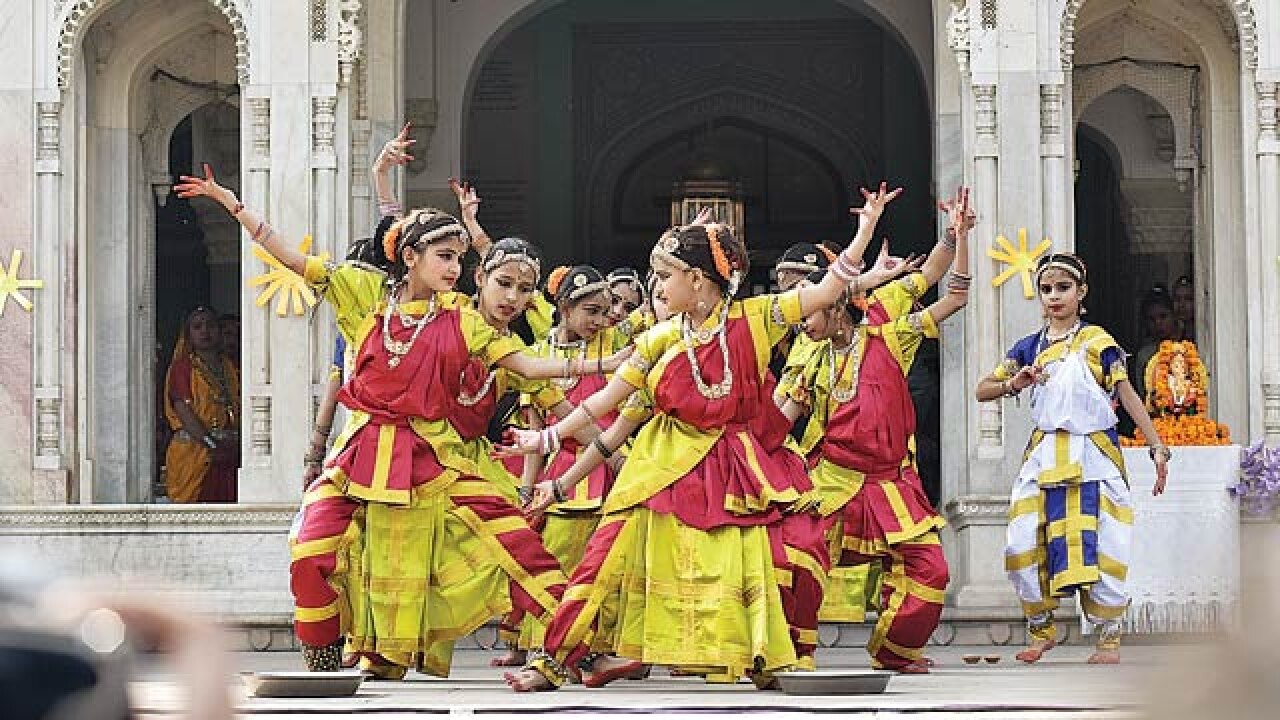
The whole audience was so impatient and restless till Rama Vaidyanathan and her daughter Dakshina brought Balakrishna, the mischievous cowherd, to life. The speeches prior to the dance, however well-intentioned, seemed to belong elsewhere. Not with the sublimity of dance, music, and worship of the Lord as a little boy that the dancers presented.
It was almost as the organizers were unwittingly guilty of auchitya-bhanga, inappropriateness tantamount to the insult of art. Why? Because they had made art subordinate to their causes. However, noble or charitable, the latter simply did not measure to the grandeur of what the dancers offered. But as soon as the first notes were sounded and the spot shone on the dancer, the atmosphere changed. Beautiful, taut, poised, and ready to spring to life, Rama transformed the thermosphere as if magically. From boring and clichéd speeches to live performance, this was the vital energy that made Indian classical art chamatkarik, miraculous.
The mother-daughter piece, third in the order of presentation, had a theme based on ancient Sangam poetry. Yet its message was really contemporary— love is also letting go. How hard a lesson this is for all of us. Here it was conveyed with an autobiographical and self-reflexive poignancy. Rama as a mother, leading her daughter to the threshold of her independence, whether that meant marriage and leaving the maternal home, or carving out her own path in the world of dance.
It is said that Zakir Hussain, Alla Rakha’s son, learned the tabla in his mother’s womb. Can there be any doubt that so did Dakshina learn dance right from the days when Rama was carrying her? The way mother and daughter “played ball” at the end of that piece summed up not just the tension between possessiveness and release, but also between traditional Bharatanatyam and modern innovation.
There was also a delight mixed with sadness in the game, the mother, embodying the pain of losing your child, while the latter, with the careless joy of youth, sparkling in anticipation of the freedom of growing into her own person.
But the dance that really riveted audience attention—and imagination—was the love offering to Lord Tyageesha of Tiruvarur. That holy shrine, sacred to all three maestros that constitute the trinity of Carnatic classical music was brought to life in Rama’s solo. The way she performed it highlighted the contrary pulls of piety and passion, fusing the two in the end into one glorious and blazing union.
After all, how does one enjoy the Lord of Renunciation (Tyagaraja)? In embracing Him, one must also relish the loss of one’s individuality, ego, and separateness. Madana’s arrows, which assail the devotee, come, after all, from the bow of same God of desire, Eros, whom Shiva burned to ashes, rendering him ananga or bodiless. To embrace Shiva, then, is to risk that self-annihilation, to lose oneself in His glory.
In Rama’s case, the dance become the Lord’s abha, the sheer luminosity that envelopes Shiva’s form like a halo. At that point, the dancer became the dance, as W. B. Yeats put it, losing her materiality, becoming weightless. Perhaps, she even become breathless, as she sat in meditation, imitating Shiva on Vishnu’s chest, enacting the ajapa natanam, a breathlessness to catch her breath as it were.
As the dancer breathes, Shiva breaths too, as does Vishnu, even though the latter is in yoga nidra, then Sesha, the thousand hooded serpent sheltering the Lord, also breathes—with every breath, a ripple of ecstasy stirs the audience, stirs the ocean of samsara, stirs the milky way; the cosmos itself vibrates with that spandana, reminding us how everything is akhilam madhuram, entirely blissful.
The balance of nritta and abhinaya, of the chiseled perfection of pure dance and the effortless fluidity of expressive emotion, combined with high-quality sahitya and sangeetam, contributes to a composite and consummate perfection of the nritya that epitomises Rama. The dancer now lives up to her name—the one who both delights in and gives delight to the Supreme. That is what, as Ananda Coomraswamy says, all our classical arts seek to do: to exalt and identify with the Divine. Dance becomes homage, consecration, and salutation to the Sacred. Art is not merely art, but theophany.
Last but not the least, each performance also inspires us to think. Art challenges is to work out the meaning not only of the performance, but of our lives. In this case, what we learn is that dvita is only apparent, as in earthly life. What the dance actually demonstrates is its opposite advita-advaita-advaya even, as when Parvati and Parameshwara become one in the symbolic form of Ardhanareeshwara. Wherever two become one — that place, that body, is sacred. For us, every confluence is a tirtha, a place of pilgrimage, reminding us of our own identity with the Absolute — chidananda rupa, Shivoham, Shivoham.
Dvita, for the discerning, is merely the mask of non-duality, of oneness, of union. To show this is Rama’s purpose. This is how the dance of the mother-daughter duo becomes yoga, a form of joining not just parent and child, guru and disciple, dancer and audience, human and Divine. It is a privilege to witness in Rama the power of parampara, transmitted from K. Lalitha to Saroja Vaidynathan, her mother-in-law, and from Rama herself to her many disciples, including her daughter. May their tribe increase.
The author is a poet, and Professor of English, JNU.